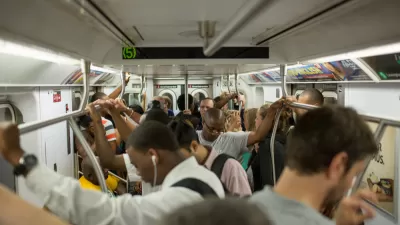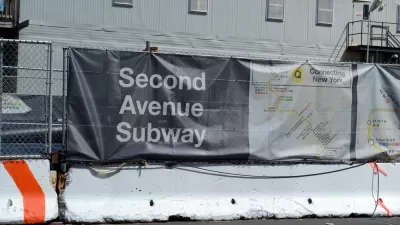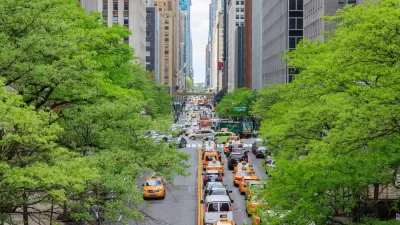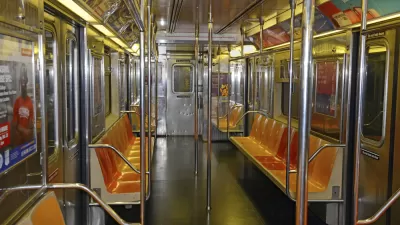Depending on what's included, the cost to rebuild the ailing 665-mile system could be $111 billion, but the city's future depends on it. A feature-length New York Times Magazine piece looks at its history and suggests ways to finance rebuilding.

"Before the subway, it was by no means a foregone conclusion that New York would become the greatest city on earth," writes Jonathan Mahler on Jan. 3. "The case for the subway is the case for mobility: physical mobility, economic mobility, social mobility."
When the city is in crisis — financial or emotional — the subway is always a crucial part of the solution. The subway led the city’s recovery from the fiscal calamity of the 1970s. The subway was at the center of the rebuilding of Lower Manhattan after the Sept. 11 attacks. The subway got New York back to work after the most devastating storm in the city’s history just five years ago.
And now, the city and the state must come to the aid of the subway, which "is "falling apart," writes Mahler, plagued by relying on outdated equipment, chronic "incidents' that cause delays, and massive overcrowding.
The subway could be both faster and safer if all of it were controlled by a computer-based signal system, which would automatically ensure that trains are always operating at the maximum safe speed, with the narrowest possible distance between them. Instead, much of the subway uses a signal system that dates to the 1920s and ’30s.
Systemwide, the biggest source of subway delays is simple overcrowding... As ridership grew from 2012 to 2016, the end-to-end running time during peak hours on the numbered lines increased by more than six minutes. Average train speeds are now slower than they were in 1950.
All these problems lead to one really big problem: The trains are terminally late, obstructed daily by a cascade of system failures. During the first three months of 2017, three-quarters of the subway’s lines were chronically behind schedule. The worst offender, the 2 train, was late nearly 70 percent of the time....
By contrast, "[t]he public-private corporation that runs Hong Kong’s subway expects 99.9 percent of its trains to run on time, and they do," observes Mahler.
The path forward
As bad as things are now, it could be far worse had it not been for the wisdom of Gov. Nelson A. Rockefeller (R) and his "infrastructure visionary by his side, William J. Ronan," wrote Marc Santora for The Times on May 18, 2017, when they engineered the state takeover of the subway and bus lines.
It was a battle of egos, pitting the giant who had remade the city’s infrastructure, Robert Moses, against a governor insistent that the state take over the entire transportation network.
At the heart of the scheme proposed by Rockefeller and Ronan was a bold idea: Because the state controlled the tolls on the city’s bridges and tunnels, it could subsidize the subway and keep fares in check. [Italics added].
So was born the Metropolitan Transportation Authority, whose enormous portfolio includes not only the subway system, but also two commuter railroads that extend to Long Island and Connecticut, and nine bridges and tunnels across the city’s five boroughs.
For better or worse, it is the state, not the city, that is in charge of the the city's subways and bus lines. Just as Rockefeller and Ronan recognized that tolls paid by motorists should be used to subsidize public transit, Gov. Andrew Cuomo (D) now finds himself in a similar situation, half a century later, with the opportunity to pursue a London-style congestion pricing plan which would add tolls to free East River and Harlem River bridges, and toll gantries in Manhattan at 60th Street.
As for opposition from Mayor Bill de Blasio (D), who prefers a "millionaires tax," Santora notes that Mayor John V. Lindsay (R) also opposed the Rockefeller-Ronan plan, as did Moses.
Emulate Hong Kong?
Another financing opportunity arises from Hong Kong, perhaps the world's most successful subway, not just due to its aforementioned on-time performance, but also its farebox recovery ratio (the percentage of operational costs covered by fares): "185 percent, the world's highest," reported Neil Padukone for The Atlantic on Sep. 10, 2013. After describing the advanced system, which includes platform screen doors, he asks, "How can Hong Kong afford all of this? The answer is deceptively simple: 'Value Capture.'”
Cambridge, Mass. proposed a 'value capture' real estate transaction fee to fund transit in 2015, but MTR Corp. takes it to an entirely different level. Padukone also relates the financing process to urban density which is also a constant theme in Mahler's piece.
Like no other system in the world, the MTR understands the monetary value of urban density—in other words, what economists call "agglomeration.” Hong Kong is one of the world’s densest cities, and businesses depend on the metro to ferry customers from one side of the territory to another. As a result, the MTR strikes a bargain with shop owners: In exchange for transporting customers, the transit agency receives a cut of the mall’s profit, signs a co-ownership agreement, or accepts a percentage of property development fees. In many cases, the MTR owns the entire mall itself.
"The M.T.A., by contrast, is largely cut out of the land profiteering that it enables: Of the authority’s roughly $16 billion budget in 2017, about $460 million came from a tax on residential real estate transactions," writes Mahler, which Brooklyn real estate developer Jed Walentas calls "insane."
“Developers build things where the subway works, and we build far fewer things where it doesn’t,” Walentas said.
Subways and the class divide
With new development can come displacement and gentrification. But subways can narrow the growing gap between rich and poor "by doing what subways do best: increasing density," writes Mahler. Case in point: East New York, Brooklyn.
East New York was recently rezoned to invite both residential and commercial development to revive the neighborhood, but with a combination of regulations and incentives that will ensure that half of the nearly 6,000 units of new housing would be affordable.
The hope is that the whole neighborhood will become more dense, and the resulting prosperity will be widely shared.
There's much more to read in this feature-length article. One of my favorite parts was the role played by Richard Ravitz, now 84, in saving the subways during the 1970's financial meltdown.
As for the aforementioned $111 billion rehabilitation price tag, that comes from a list prepared by the Regional Plan Association mentioned by Mahler.
Additional reading: "How Politics and Bad Decisions Starved New York’s Subways," by Brian M. Rosenthal, Emma G. Fitzsimmons And Michael Laforgia, Nov. 18, 2017, New York Times.

Maui's Vacation Rental Debate Turns Ugly
Verbal attacks, misinformation campaigns and fistfights plague a high-stakes debate to convert thousands of vacation rentals into long-term housing.

Planetizen Federal Action Tracker
A weekly monitor of how Trump’s orders and actions are impacting planners and planning in America.

In Urban Planning, AI Prompting Could be the New Design Thinking
Creativity has long been key to great urban design. What if we see AI as our new creative partner?

How Trump's HUD Budget Proposal Would Harm Homelessness Response
Experts say the change to the HUD budget would make it more difficult to identify people who are homeless and connect them with services, and to prevent homelessness.

The Vast Potential of the Right-of-Way
One writer argues that the space between two building faces is the most important element of the built environment.

Florida Seniors Face Rising Homelessness Risk
High housing costs are pushing more seniors, many of them on a fixed income, into homelessness.
Urban Design for Planners 1: Software Tools
This six-course series explores essential urban design concepts using open source software and equips planners with the tools they need to participate fully in the urban design process.
Planning for Universal Design
Learn the tools for implementing Universal Design in planning regulations.
Gallatin County Department of Planning & Community Development
Heyer Gruel & Associates PA
JM Goldson LLC
City of Camden Redevelopment Agency
City of Astoria
Transportation Research & Education Center (TREC) at Portland State University
Jefferson Parish Government
Camden Redevelopment Agency
City of Claremont





























